
Duxford is a village in Cambridgeshire, England, about 10 miles (16 km) south of Cambridge. It is part of the Hundred Parishes area.

Wensleydale is the dale or upper valley of the River Ure on the east side of the Pennines, one of the Yorkshire Dales in North Yorkshire, England.

Swaledale is one of the northernmost dales (valleys) in Yorkshire Dales National Park, located in northern England. It is the dale of the River Swale on the east side of the Pennines in North Yorkshire.
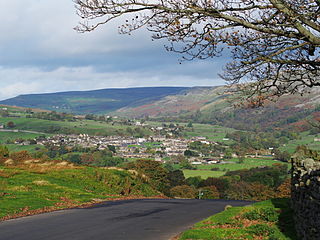
Reeth is a village 11 miles (18 km) west of Richmond in the Richmondshire district of North Yorkshire, England, in the civil parish of Reeth, Fremington and Healaugh. Historically part of the North Riding of Yorkshire, it is the principal settlement of upper Swaledale.

Muker is a village and civil parish at the western end of Swaledale in North Yorkshire, England, within the district of Richmondshire.
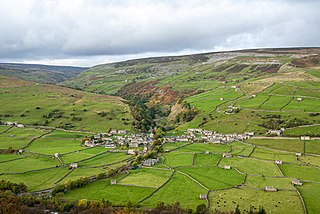
Gunnerside is a village in the Richmondshire district of North Yorkshire, England. It is situated on the B6270 road, 2 miles (3 km) east of Muker and 6 miles (10 km) west of Grinton. The village lies between the River Swale and its tributary, Gunnerside Beck, in the Swaledale part of the Yorkshire Dales National Park.
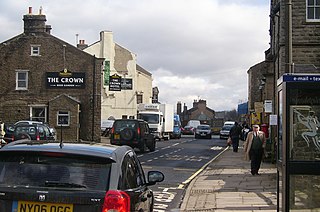
Hawes is a market town and civil parish in the Richmondshire district of North Yorkshire, England, at the head of Wensleydale in the Yorkshire Dales, and historically in the North Riding of Yorkshire. The River Ure north of the town is a tourist attraction in the Yorkshire Dales National Park.

Freeby is a village and civil parish in the Melton district of Leicestershire, England, about 3 miles (5 km) east of Melton Mowbray. As well as the village of Freeby the civil parish includes the villages of Brentingby, Saxby, Stapleford and Wyfordby. The 2011 Census recorded the parish population as 244.

Keld is a village in the English county of North Yorkshire. It is in Swaledale, in the district of Richmondshire and the Yorkshire Dales National Park. The name derives from the Viking word Kelda meaning a spring and the village was once called Appletre Kelde – the spring near the apple trees.

Grinton is a small village and civil parish in the Yorkshire Dales, in the Richmondshire district of North Yorkshire, England. Close to Reeth and Fremington, it lies 9 miles (15 km) west of Richmond on the B6270 road.

Todmorden Unitarian Church is a Unitarian church located in Honey Hole Road, Todmorden, West Yorkshire, England. Built in honour of John Fielden, a local mill owner and a social reformer, the church was completed in 1869. It was declared redundant in 1987 and came under the care of the Historic Chapels Trust. Since 2008, regular services have been held in the building, but it remains in the care of the Trust. The church is recorded in the National Heritage List for England as a designated Grade I listed building,
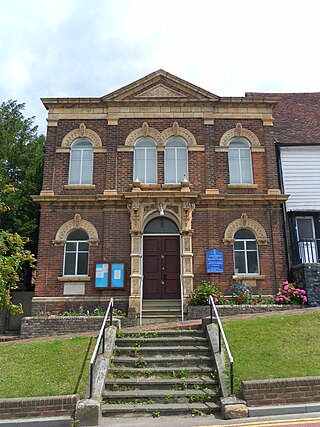
Robertsbridge United Reformed Church is a former United Reformed Church place of worship in Robertsbridge, a village in the district of Rother in the English county of East Sussex. Built for Congregational worshippers in 1881 following their secession from a long-established Wesleyan Methodist chapel, it was the third Nonconformist place of worship in the village, whose nearest parish church was in the neighbouring settlement of Salehurst. Like the former Strict Baptist and Methodist chapels in the village, which have both closed, it no longer serves Robertsbridge as a place of worship. Local architect Thomas Elworthy's distinctive design—a "rich" and highly decorated blend of several styles—has divided opinion amongst architectural historians. English Heritage has listed the church at Grade II for its architectural and historical importance.

Grinton Lodge is a 19th-century former shooting lodge that has been a youth hostel since 1948. A Grade II listed building, it is situated above the village of Grinton, in Swaledale, North Yorkshire, England.

West Park United Reformed Church is located in the West Park area of Harrogate, England, and is a Grade II listed building. It was designed in Nonconformist Gothic style as West Park Congregational Church by Lockwood & Mawson and completed in 1862 for around £5,000. Along with Belvedere Mansion across the road, it was intended as part of the prestigious entrance to the Victoria Park development. For the Congregationalists it was meant to house an increasing congregation of visitors brought to the spa town by the recently-built railways. It became a United Reformed church in 1972.

The building formerly known as Godalming Congregational Church was the Congregational chapel serving the ancient town of Godalming, in the English county of Surrey, between 1868 and 1977. It superseded an earlier chapel, which became Godalming's Salvation Army hall, and served a congregation which could trace its origins to the early 18th century. The "imposing suite of buildings", on a major corner site next to the Town Bridge over the River Wey, included a schoolroom and a manse, and the chapel had a landmark spire until just before its closure in 1977. At that time the congregation transferred to the nearby Methodist chapel, which became a joint Methodist and United Reformed church with the name Godalming United Church. The former chapel then became an auction gallery before being converted into a restaurant; then in 2018 the premises were let to the Cotswold Company to be converted into a furniture and home accessories showroom. In 1991 the former chapel was listed at Grade II for its architectural and historical importance.
Alfred Hill Thompson, ARIBA was an English architect in the Gothic Revival and Arts and Crafts styles, who specialised in small schools and chapels in the Yorkshire area. In partnership with Isaac Thomas Shutt he co-designed the Church of All Saints, Harlow Hill, completed in 1871.
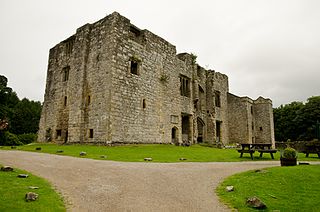
Barden Tower is a ruined building in the Parish of Barden, in Wharfedale, North Yorkshire, England. The tower was used as a hunting lodge in the 15th and 16th centuries, and despite a renovation in the 1650s, it fell into disrepair in the 18th century. The tower is now part of the Bolton Estate and is listed as a medieval fortified tower. Along with other buildings on the Bolton Estate, it is a focal point and many people visit the tower. It is also a way marker on the 100-mile (160 km) Lady Anne's Way long distance path.

The Church of St Andrew, Grinton, is the parish church for the village of Grinton in North Yorkshire, England. The grade I listed structure has also been called The Cathedral of the Dales, and as the only parish church in Upper Swaledale, it was at the end of the Swaledale Corpse Way, where those who had died in the upper valley, were brought for burial. Grinton never developed past village status, but its noted crossing point of the River Swale afforded it more importance than other settlements.

The Church of St Mary the Virgin is an Anglican church in the Upper Swaledale village of Muker, in North Yorkshire, England. It is one of four churches in the ecclesiastical Parish of Swaledale with Arkengarthdale. The church was constructed in 1580, but previous to this, a chapel-of-ease had stood on the site which came under the Church of St Andrew in Grinton. Until the consecration of St Mary's, baptisms, weddings and funerals, had to be conducted at the church in Grinton. The Church of St Mary the Virgin, is noted for being a rare example of a house of worship being built during the Elizabethan era.

The Weybridge United Reformed Church situate at Queen's Road, Weybridge, near to its junction with York Road, is a Victorian Grade II Listed church building that is now no longer used as a place of worship.






















